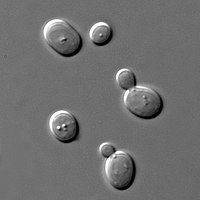
Photo from wikipedia
Three experiments were conducted to test the hypothesis that the standardized ileal digestibility (SID) of AA, concentrations of DE and ME, and the standardized total tract digestibility (STTD) of P… Click to show full abstract
Three experiments were conducted to test the hypothesis that the standardized ileal digestibility (SID) of AA, concentrations of DE and ME, and the standardized total tract digestibility (STTD) of P in a source of torula yeast are not different from values obtained in Menhaden fish meal. In experiment 1, six weanling barrows (initial BW: 11.7 ± 0.4 kg) were prepared with a T-cannula in the distal ileum and allotted to a replicated 3 × 3 Latin square design with 3 diets and 3 periods. In each period, there were 5 d of adaptation and 2 d of collection. Two cornstarch-based diets using the torula yeast or fish meal as the sole source of AA and a N-free diet were formulated. The SID of CP and all AA was greater (P < 0.05) in torula yeast than in fish meal. In experiment 2, 24 weanling barrows (initial BW: 14.4 ± 1.1 kg) were individually housed in metabolism crates and allotted to a corn-based diet or 2 diets based on a mixture of corn and torula yeast or corn and fish meal. Feces and urine samples were collected for 4 d following a 5-d adaptation period. There were 8 replicate pigs per diet and fecal and urine materials were collected. Results of this experiment indicated that there were no differences in the concentration of DE and ME (DM basis) between torula yeast and fish meal. In experiment 3, a total of 32 weanling barrows (initial BW: 11.9 ± 1.1 kg) were allotted to 4 diets and 8 replicate pigs per diet. Pigs were placed in individual metabolism crates. The torula yeast or fish meal were used in 2 diets containing either 0 or 500 units of microbial phytase. Feces samples were collected as described for experiment 2. The STTD of P in torula yeast was greater (P < 0.05) than in fish meal, but regardless of ingredient, there was no effect of the inclusion of phytase in the diets. In conclusion, the SID of AA and the STTD of P in torula yeast is greater than in fish meal, but values for the concentration of DE and ME in torula yeast are not different from those in fish meal. Therefore, the torula yeast that was used in the present experiments may be included at the expense of fish meal in diets fed to weanling pigs if the concentration of standardized ileal digestible AA is considered in the formulation.
Journal Title: Journal of animal science
Year Published: 2020
Link to full text (if available)
Share on Social Media: Sign Up to like & get
recommendations!